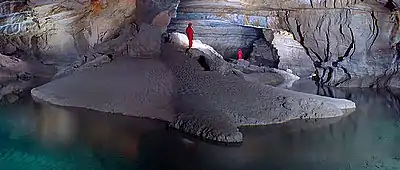Underground lake
An underground lake or subterranean lake is a lake under the surface of the Earth. Such lakes may be associated with caves, aquifers, or springs. They are typically very low in salinity.

Subterranean isle in one of the 22 lakes in Cross Cave in Slovenia
The largest non-subglacial lake in the world is in Dragon's Breath Cave in Namibia,[1] with an area of almost 2 hectares (5 acres),[2] and the second largest is in Craighead Caverns in Tennessee, United States.
See also
- Subglacial lake – A lake under a glacier
- Subterranean river – A river that runs wholly or partly beneath the ground surface
- Subterranean waterfall
References
- Kelly, Daniel (24 January 2014). "Dragon's Breath Cave Holds the World's Largest Underground Lake". Lake Scientist. Archived from the original on 1 March 2015. Retrieved 31 May 2016.
- "Dragon's Breath, Namibia". National Geographic. Retrieved 28 August 2012.
This article is issued from Wikipedia. The text is licensed under Creative Commons - Attribution - Sharealike. Additional terms may apply for the media files.